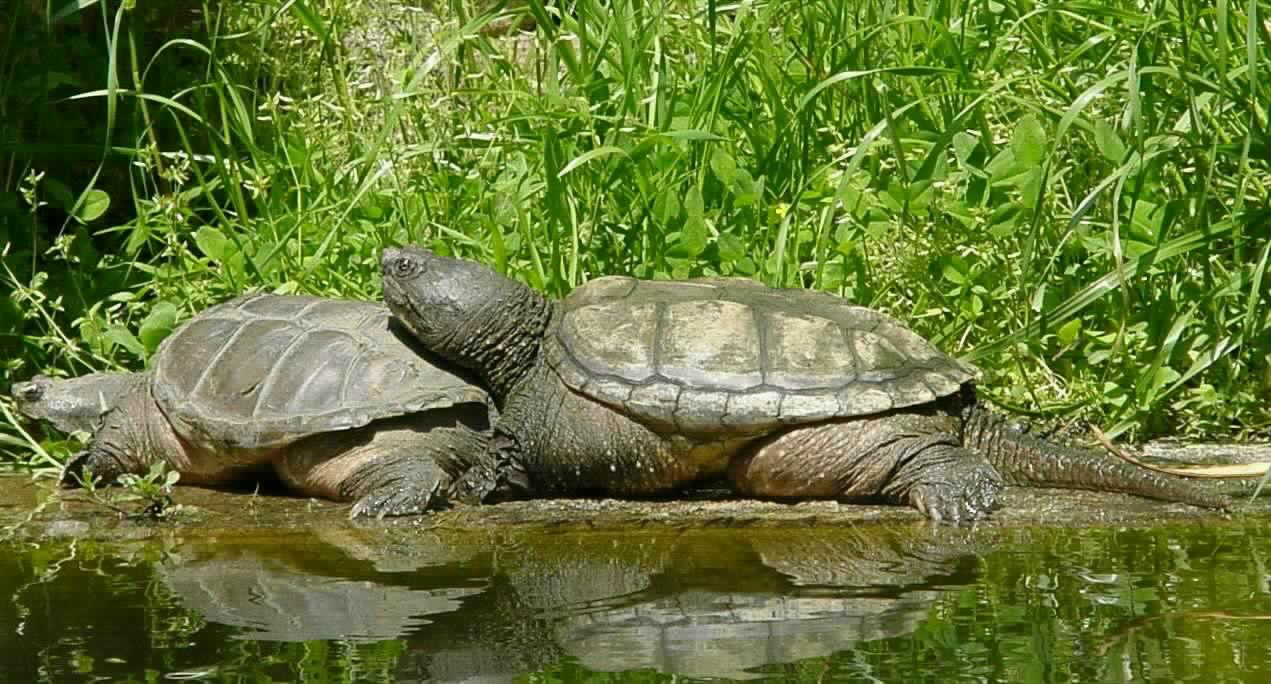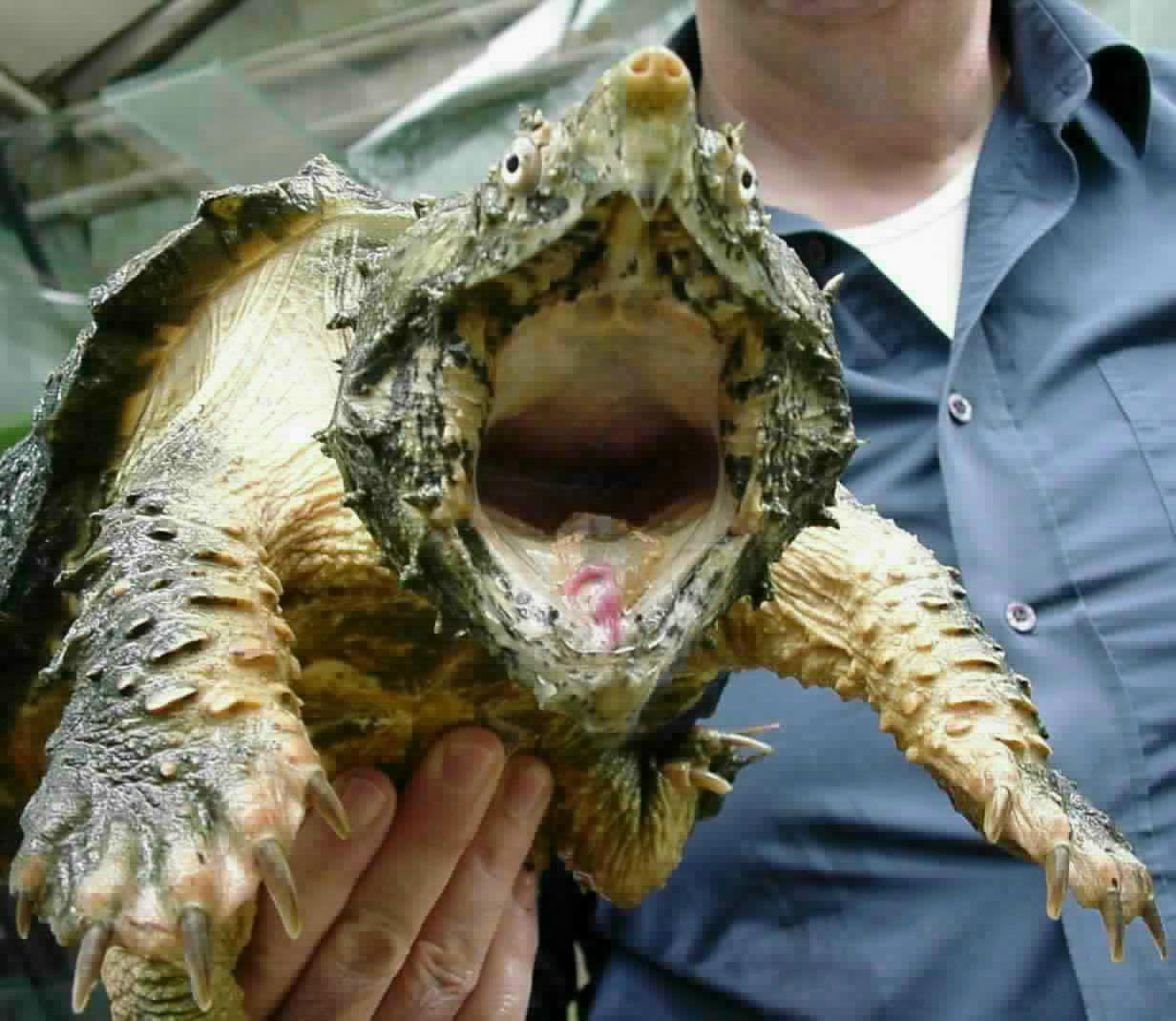
The Snapping Turtles are well-known (at least in North America), the Big-Headed Turtle less so. None of these species can withdraw their heads into their shells: the Big-Headed Turtle has a toughened head to compensate, while the Snappers have a generally mean disposition instead.
The characteristics of the family are as follows:
As regards the keeping of these species in captivity, the American and the Asian species should be considered separately.
The Big-Headed Turtle, despite its name, is not a large creature, but does have somewhat specialised requirements as it lives in high, cool shallow areas of running water, as well as apparently feeling the need every now and then to climb something. Thus the problem here is not the temperament of the creature but providing it with the right setup. However, notes that despite its "low" of 12 deg C, the species is quite happy at a high of 25 deg C, so this is not like the situation with certain salamanders where even moderate amounts of warmth can be dangerous. Captive breeding would be most desirable for this species as it has a low reproductive rate in the wild: unfortunately there has been little success to date and information on its breeding habits in the wild remains very sparse (practically non-existent). Müller has details on captive care.
With the Snapping Turtles the situation is reversed. Snappers of either species will tolerate the most basic (not to mention disgusting) conditions in the wild, including sewers, which might make them ideal pets were it not for (a) their huge size, which makes keeping them indoors impractical when they are fully grown (although Alligator Snappers are not overly active), and (b) their temperament, which is at best testy and at worst nasty. That is not a value judgement, it is simply the way they are. They are certainly not chelonians that will allow their heads to be stroked in the same way as one would a long-term captive Testudo hermanni. Since the bite of the Alligator Snapper can sever fingers, this is a warning to be taken seriously. Serious adult keepers would probably do all right by keeping one in a suitably sized pond or enclosure in a garden, although this may not suit Macroclemmys if you live in a temperate or cold climate. Chelydra are more tolerant, at least in the northern part of the range, and might be do fine in the more northerly parts of Asia, Europe or America. The need for captive breeding is probably not great at the moment, at least for Chelydra, since there is not much of a market for the youngsters and it might be hard to dispose of them responsibly. Furthermore, there is as far as I aware no indication that these species are communal: most seem to lead solitary lives: adult Chelydra males can certainly not be held together [Müller], and Macroclemmys kept together should all be of a similar size [ibid]. It goes without saying that a captive should never be released into the wild, since if it survives it may not reproduce but it could cause damage to native wildlife. Once past the juvenile stage, neither species has any natural enemies other than man.
For details of captive care, see Bartlett & Bartlett and Müller. It is also worth checking legislation covering your area concerning the keeping of the two North American genera, since for example in France all species of Chelydra are considered dangerous by the law.
Macroclemmys is a protected species in the wild.
| QUICK INDEX | ||
| Chelydra, Common Snapping Turtle | Macroclemmys, Alligator Snapper | Platycephalum, Big-Headed Turtle |
| Species Name | Common Name | Location | Size | Notes |
| C. serpentina | Snapping Turtle [D: Fr: Chélydre serpentine] | S Canada, USA (east of Rockies), Mexico, Guatemala, Honduras, Costa Rica, Nicaragua, Panama, Colombia and Ecuador, poss. El Salvador and Belize | 12-18" | This is a relatively common species throughout its range, and in some areas is farmed for food. In the northern part of its range it is diurnal, but in the south may be more nocturnal. It is more active than the Alligator Snapper. Preferred areas are quiet lakes and bodies of water rather than fast-moving rivers: the animals tend to spend most of their time submerged and only occasionally bask on land. As a result the carapace often receives a certain amount of algae growth, which further assists the turtle in its camouflage. The diet consists mainly of animal matter but also some plant matter: carrion is also eagerly taken. Description: triangular-sided head ending in hooked beak and with 2 barbels on the chin. The carapace is smooth and relatively thin, but with three slight keels: the scutes have slightly raised "ray" formations running fan-wise out from one corner. The carapace is attached to plastron by cartiliginous bridges. Inframarginals are quite narrow. Toes are slightly webbed. Coloration: carapace dark- to blackish-brown, carapace yellowish-brown, limbs olive-grey. Reproduction: males are usually significant larger than females and in comparison have a reduced plastron. Female lays about 15 eggs, either in pits up to 10cm deep or in abandoned rat holes. Incubation time is about 100 days. |
| C. s. serpentina | Northern Common Snapping Turtle | S Canada, E USA, Mexico, N South America | ||
| C. s. acutirostris | Ecuadorian Snapping Turtle | Panama and Ecuador | ||
| C. s. osceola | Florida Snapping Turtle | USA (Florida peninsula) | Most easily distinguishable subspecies owing to a number of swellings on the neck and adjacent parts of the body. | |
| C. s. rossignonii | Mexican Snapping Turtle | C America (Guatemala south as far as Costa Rica) |

| Species Name | Common Name | Location | Size | Notes |
| M. temminckii | Alligator Snapping Turtle, Alligator Snapper [D: Geierschildkröte Fr: La Tortue alligator] | SE USA (N Florida, SW Georgia, Alabama exc. north, Mississippi, Louisiana, E Texas, Arkansas, W Tennessee, E Oklahoma, SE Kansas: along Mississippi Valley in W Kentucky, E Missouri, W Illinois and SE Iowa) | 15-26", max 31½" | Although one of the largest freshwater turtles in the world and the largest in North America, this is actually a fairly sedentary creature that spends most of its time in the water and only occasionally basks on land. It is nowadays mainly confined to the drainages of the Mississippi [Alderton] and SE coastal plain [Bartlett & Bartlett]. It is carnivorous and unlike Chelydra does not take so much plant matter (that which is is possibly seized involuntarily). An interesting feature of the Alligator Snapper is its "lure". This is a worm-like protuberance in the inside of its lower jaw: normally grey, it becomes pink when engorged with blood by its owner, who then exposes it by opening its mouth. The lure attracts curious fish or other creatures, which are then consumed by the turtle. Macroclemmys in fact consumes a wide range of prey items, both vertebrate and invertebrate [see Bartlett & Bartlett]. Description: carapace has three alligator-like ridges along the back. It also possesses additional plates between the pleural plates and marginal plates, the only living turtle species to do so. Toes are webbed. Coloration: carapace blackish-brown, carapace yellowish-brown, limbs grey. Reproduction: one clutch of eggs per year is laid. Clutch size varies with age of female from 6-50 eggs. Incubation time in the wild is about 3-4 months [Bartlett & Bartlett]. |
 |
 |
| Frontal view of M. temmincki in threat posture after being picked up. Note the pinkish, worm-like "lure" on the base of the mouth. | Side view of the same animal. |
| Species Name | Common Name | Location | Size | Notes |
| P. megacephalum | Big-Headed Turtle | SE Asia | ?" | The Big-Headed Turtle lives in mountainous country where it inhabits shallow, stony cool brooks. It can be mobile at temperatures as low as 12 deg C, which would immobilise many other reptiles (although the Chinese Crocodile Lizard is also tolerant of low warmth levels). The top of the head is covered with large horny plates: likewise the tail (nearly as long as the shell) is covered with sturdy plates, and the legs with sturdy scales. There is a complete row of inframarginals on the bridge. The beak is sharp and hooked like a parrot's. One of the most interesting, and peculiar, abilities of this species is its climbing: Heinz Wermuth relates that he once found a captive 3m above the ground clinging to a curtain. Reproduction: female lays 2 eggs. |
| P. m. megacephalum | S China (Kwangxi and Kwangtung Provinces inc. Hainan) | |||
| P. m. peguense | S Burma, Thailand (not NW) and Indochina | |||
| P. m. tristernalis | SW China (Yunnan Province) | |||
| P. m. vogeli | NW Thailand |
Turtles and Tortoises: A Complete Pet Owner's Manual, R D and P Bartlett, Barron's Educational Series, New York 1996.
Stan Gielewski's Snapping Turtle Page - a site dedicated to Snapping Turtles of both species. Definitely worth a visit!
Victor Freeman's Snapping Turtles page has an interesting account of how he acquired his turtle and how he keeps it in an indoor setup.
Kingsnake.com's Snapping Turtle Forum.
Your Florida Backyard has a page on Snapping Turtles of both species, as well as much interesting information and pictures of other indigenous wildlife.
A Geocities page on Snapping Turtles - quite informative and nicely laid out.
David T Kirkpatrick's useful article on P. megacephalum.
World Chelonian Trust's Platysternon Gallery at www.chelonia.org.
Close-up picture of the head of P. megacephalum by Dr Zoltan Takacs.
Back to Chelonian Families | Back to Chelonians | Back to Reptiles | Back to Herps | Back to Home Page